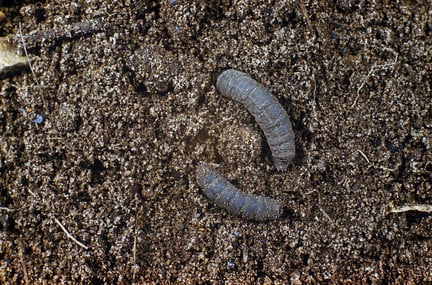
Quick facts
Common name - Leatherjackets, daddy-longlegs, crane flies
Scientific name - Tipula spp.
Plants affected - Mainly lawn grasses but also seedlings and small plants
Main symptoms - Lawns develop yellowish brown dead patches; seedlings collapse having been eaten at soil level; presence of leatherjackets in the soil
Caused by - The larval stage of crane flies or daddy-longlegs
Timing - February-October
What are leatherjackets?
Leatherjackets are the larvae of craneflies. A broad classification spanning six true fly families (Tipulidae, Pediciidae, Limoniidae, Cylindrotomidae, Trichoceridae and Ptychopteridae) there are around 350 species in Britain many are uncommon or rare. These insects are part of healthy balanced ecosystems, most feed on decomposing organic matter or algae and some are predatory. A few species feed on living plant material and a small number of these may cause damage in gardens.
Symptoms
How to tell if leatherjackets are a problem in your garden:
- Leatherjackets have elongate tubular bodies, up to 30 mm long, and are greyish brown. They have no legs or obvious head
- Lawns develop patches where the grasses turns yellowish brown and often dies. This can be distinguished from similar effects caused by lawn diseases or adverse growing conditions by lifting the affected turf and finding leatherjackets in the surface layers of the soil
- Leatherjackets may also be revealed in lawns by soaking with water and covering with material impervious to light, such as black polythene. The following day if leatherjackets are the problem, large numbers of grubs should be found on the lawn surface under the cover
- Crows, magpies, rooks and starlings will search for leatherjackets in turf. These birds leave small round holes in the turf where they have inserted their beaks. They will also search for chafer grubs in a similar manner
- In flower beds or vegetable plots, and small plants can be killed when the stems are damaged at soil level
Management
Biological control is available for controlling leatherjackets in lawns, flower beds and vegetable plots. These are pathogenic nematodes, Steinernema feltiae or S. carpocapsae, which are watered into the turf or soil. The nematodes enter the bodies of leatherjackets and infect them with a bacterial disease. They are not specific to leatherjackets and may also affect other insects in the soil and so should be used in a targeted manner. To be effective, the nematodes require soil that is well drained but moist and with a minimum temperature of 12°C (54°F). The turf around the edge of affected areas should be targeted to deal with larvae spreading out from “hot spots” in the lawn. However, by the time damage becomes apparent, the soil may be too cold for nematodes to be effective.
As a preventive measure, nematodes can be applied in September to early October against leatherjackets. Nematodes should be applied as soon as possible after purchase, following the suppliers’ instructions for use. It may be necessary to water the lawn before and after application to ensure the soil is sufficiently moist for nematode activity and survival.
Download
Biological control suppliers (pdf document)
Biology
There are several species of leatherjackets (larvae of crane flies) that feed on the roots and stem bases of lawn grasses and other plants. Most species of crane fly do not damage plants, many feed on decaying organic matter and help in nutrient recycling and are a part of a healthy garden.
The adult crane flies or daddy-longlegs mostly emerge and lay eggs in the turf or soil surface from August to October. Dry soil conditions at that time can result in many of the eggs failing to hatch, so large numbers of adult flies does not necessarily mean that there will be large numbers of larvae or leatherjackets in the next year.
The eggs hatch a few weeks after they have been laid and the young leatherjackets begin feeding on plant roots. In cold winters, they overwinter as small larvae and do not grow large enough to cause significant damage until mid-summer. Mild winters allow the young larvae to continue feeding and they can be large enough to cause lawn problems by late winter.
When fully grown, the leatherjackets pupate in the soil. When the adult flies emerge, the pupal case is often partly pulled out of the ground and left sticking up above the lawn surface.










